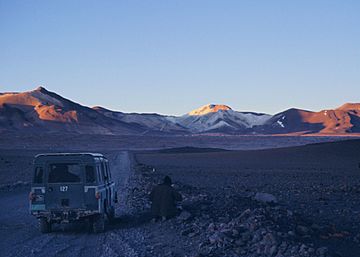Cerro Escorial facts for kids
Quick facts for kids Cerro Escorial |
|
|---|---|

Road to Mina Julia on Cerro Escorial (1970).
|
|
| Highest point | |
| Elevation | 5,451 m (17,884 ft) |
| Geography | |
| Location | Argentina and Chile |
| Parent range | Andes |
| Geology | |
| Mountain type | Stratovolcano |
Cerro Escorial is a stratovolcano, which is a tall, cone-shaped volcano. It sits right on the border between Argentina and Chile. It's the newest volcano in a group called the Corrida de Cori volcanic group.
At the very top of Cerro Escorial, there is a large, well-preserved crater. This crater is about 1 kilometer (0.6 miles) wide. You can find lava flows on both sides of the volcano. The flows on the Chilean side are larger. They reach up to 4 kilometers (2.5 miles) away from the volcano. Scientists have found that one of these lava flows is about 342,000 years old.
Contents
How Cerro Escorial Formed
Cerro Escorial is part of the mighty Andes mountain chain. The Andes formed because of a process called subduction. This happens when one of Earth's huge plates, the Nazca Plate, slides underneath another plate, the South America Plate.
This movement also created a high plateau called the Altiplano-Puna. Cerro Escorial rises from this plateau. A special crack in the Earth's surface, called the Archibarca lineament, runs through the area. This crack helped magma (molten rock) from deep inside the Earth rise to the surface.
Volcanic Activity and Eruptions
Over a very long time, Cerro Escorial erupted different types of lava.
- Older lavas, called andesite, erupted millions of years ago.
- A powerful eruption, known as a Plinian eruption, happened about 460,000 years ago.
- This eruption created a huge cloud of ash and rock.
- It also produced a type of volcanic rock called ignimbrite. This ignimbrite is also known as the Corrida de Cori ignimbrite.
- The ignimbrite covered a large area, about 0.6 cubic kilometers (0.14 cubic miles) in volume.
After this big eruption, more lava flowed from the volcano. A smaller, cone-shaped hill made of cinders, called a cinder cone, also formed. Today, there isn't much volcanic activity. Any activity is mostly hot water and steam coming from the ground. Since there are no towns or people living very close, any future activity would likely not affect anyone.
Nearby Sulfur Mine
About 4 kilometers (2.5 miles) southwest of Cerro Escorial, there used to be a sulfur mine. Sulfur is a yellow mineral. This mine stopped operating around 1983.
See also
 In Spanish: Cerro Escorial para niños
In Spanish: Cerro Escorial para niños
- List of volcanoes in Chile
- List of volcanoes in Argentina
Sources

